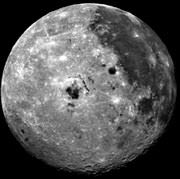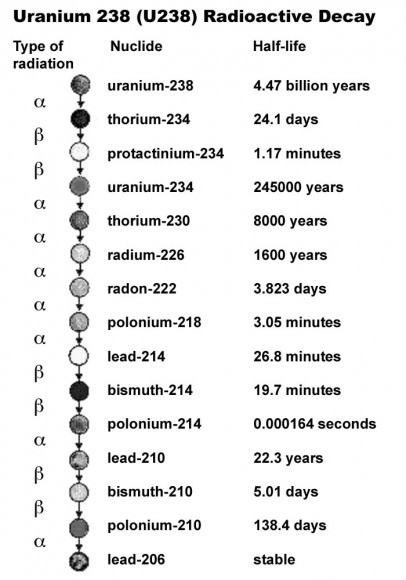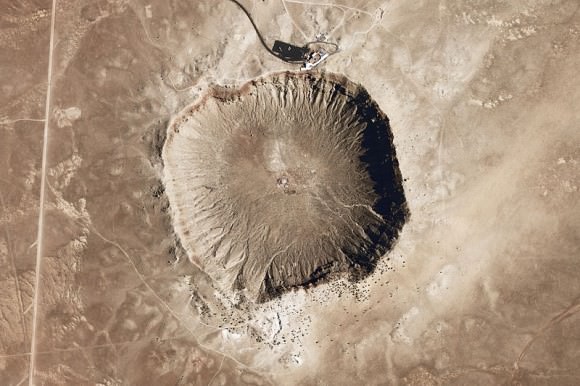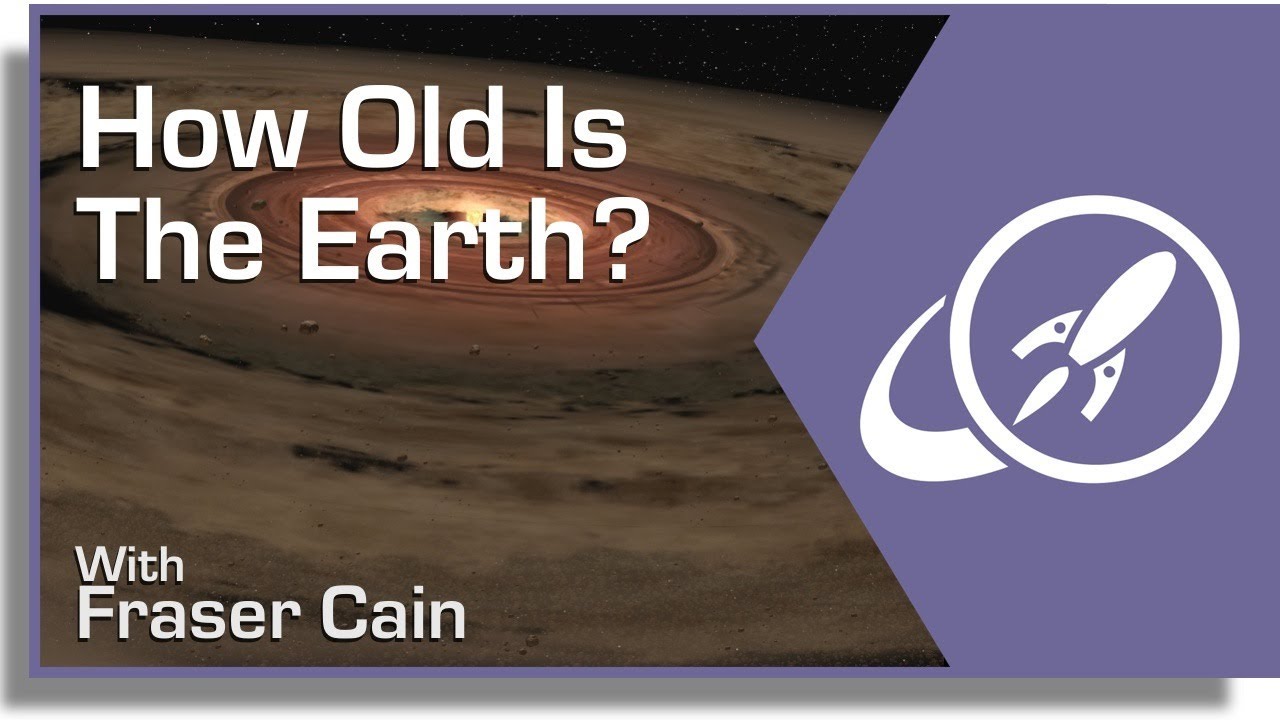This article comes from the Universe Today archive, but was updated with this spiffy video.
How old is the Earth? Scientists think that the Earth is 4.54 billion years old. Coincidentally, this is the same age as the rest of the planets in the Solar System, as well as the Sun. Of course, it’s not a coincidence; the Sun and the planets all formed together from a diffuse cloud of hydrogen billions of years ago.
In the early Solar System, all of the planets formed in the solar nebula; the remnants left over from the formation of the Sun. Small particles of dust collected together into larger and larger objects – pebbles, rocks, boulders, etc – until there were many planetoids in the Solar System. These planetoids collided together and eventually enough came together to become Earth-sized.
At some point in the early history of Earth, a planetoid the size of Mars crashed into our planet. The resulting collision sent debris into orbit that eventually became the Moon.
How do scientists know Earth is 4.54 billion years old? It’s actually difficult to tell from the surface of the planet alone, since plate tectonics constantly reshape its surface. Older parts of the surface slide under newer plates to be recycled in the Earth’s core. The oldest rocks ever found on Earth are 4.0 – 4.2 billion years old.
Scientists assume that all the material in the Solar System formed at the same time. Various chemicals, and specifically radioactive isotopes were formed together. Since they decay in a very known rate, these isotopes can be measured to determine how long the elements have existed. And by studying different meteorites from different locations in the Solar System, scientists know that the different planets all formed at the same time.
Failed Methods for Calculating the Age of the Earth
Our current, accurate method of measuring the age of the Earth comes at the end of a long series of estimates made through history. Clever scientists discovered features about the Earth and the Sun that change over time, and then calculated how old the planet Earth is from that. Unfortunately, they were all flawed for various reasons.
- Declining Sea Levels – Benoit de Maillet, a French anthropologist who lived from 1656-1738 and guessed (incorrectly) that fossils at high elevations meant Earth was once covered by a large ocean. This ocean had taken 2 billion years to evaporate to current sea levels. Scientists abandoned this when they realized that sea levels naturally rise and fall.
- Cooling of the Earth –
 William Thompson, later known as Lord Kelvin, assumed that the Earth was once a molten ball of rock with the same temperature of the Sun, and then has been cooling ever since. Based on these assumptions, Thompson calculated that the Earth took somewhere between 20 and 400 million years to cool to its current temperature. Of course, Thompson made several inaccurate assumptions, about the temperature of the Sun (it’s really 15 million degrees Kelvin at its core), the temperature of the Earth (with its molten core) and how the Sun is made of hydrogen and the Earth is made of rock and metal.
William Thompson, later known as Lord Kelvin, assumed that the Earth was once a molten ball of rock with the same temperature of the Sun, and then has been cooling ever since. Based on these assumptions, Thompson calculated that the Earth took somewhere between 20 and 400 million years to cool to its current temperature. Of course, Thompson made several inaccurate assumptions, about the temperature of the Sun (it’s really 15 million degrees Kelvin at its core), the temperature of the Earth (with its molten core) and how the Sun is made of hydrogen and the Earth is made of rock and metal. - Cooling of the Sun – In 1856, the German physicist Hermann Ludwig Ferdinand von Helmholtz attempted to calculate the age of the Earth by the cooling of the Sun. He calculated that the Sun would have taken 22 million years to condense down to its current diameter and temperature from a diffuse cloud of gas and dust. Although this was inaccurate, Helmholtz correctly identified that the source of the Sun’s heat was driven by gravitational contraction.
- Rock Erosion – In his book, The Origin of Species by Means of Natural Selection, Charles Darwin proposed that the erosion of chalk deposits might allow for a calculation of the minimum age of the planet. Darwin estimated that a chalk formation in the Weald region of England might have taken 300 million years to weather to its current form.
- Orbit of the Moon – George Darwin, the son of Charles Darwin, guessed that the Moon might have been formed out of the Earth, and drifted out to its current location. The fission theory proposed that the Earth’s rapid rotation caused a chunk of the planet to spin off into space. Darwin calculated that it had taken the Moon at least 56 million years to reach its current distance from Earth. We now know the Moon was probably formed when a Mars-sized object smashed into the Earth billions of years ago.
- Salinity of the Ocean – In 1715, the famous astronomer Edmund Halley proposed that the salinity of the oceans could be used to estimate the age of the planet. Halley observed that oceans and lakes fed by streams were constantly receiving more salt, which then stuck around as the water evaporated. Over time, the water would be come saltier and saltier, allowing an estimate of how long this process has been going on. Various geologists used this method to guess that the Earth was between 80 and 150 million years old. This method was flawed because scientists didn’t realize that geologic processes are extracting salt out of the water as well.

Radiometric Dating Provides an Accurate Method to Know the Age of the Earth
In 1896, the French chemist A. Henri Becquerel discovered radioactivity, the process where materials decay into other materials, releasing energy. Geologists realized that the interior of the Earth contained a large amount of radioactive material, and this would be throwing off their calculations for the age of the Earth. Although this discovery revealed flaws in the previous methods of calculating the age of the Earth, it provided a new method: radiometric dating.
Geologists discovered that radioactive materials decay into other elements at a very predictable rate. Some materials decay quickly, while others can take millions or even billions of years to fully decay. Ernest Rutherford and Frederick Soddy, working at McGill University, determined that half of any isotope of a radioactive element decays into another isotope at a set rate. For example, if you have a set amount of Thorium-232, half of it will decay over a billion years, and then half of that amount will decay in another billion years. This is the source of the term “half life”.

By measuring the half lives of radioactive isotopes, geologists were able to build a measurement ladder that let them accurately calculate the age of geologic formations, including the Earth. They used the decay of uranium into various isotopes of lead. By measuring the amount of three different isotopes of lead (Pb-206, Pb-207, and Pb-208 or Pb-204), geologists can calculate how much Uranium was originally in a sample of material.
If the Solar System formed from a common pool of matter, with uniformly distributed Pb isotopes, then all objects from that pool of matter should show similar amounts of the isotopes. Also, over time, the amounts of Pb-206 and Pb-207 will change because as these isotopes are end-products of uranium decay. This makes the amount of lead and uranium change. The higher the uranium-to-lead ratio of a rock, the more the Pb-206/Pb-204 and Pb-207/Pb-204 values will change with time. Now, supposing that the source of the Solar system was also uniformly distributed with uranium isotopes, then you can draw a data line showing a lead-to-uranium plot and, from the slope of the line, the amount of time which has passed since the pool of matter became separated into individual objects can be computed.
Bertram Boltwood applied this method of dating to 26 different samples of rocks, and discovered that they had been formed between 92 and 570 million years old, and further refinements to the technique gave ages between 250 million to 1.3 billion years.
Geologists set about exploring the Earth, seeking the oldest rock formations on the planet. The oldest surface rock is found in Canada, Australia and Africa, with ages ranging from 2.5 to 3.8 billion years. The very oldest rock was discovered in Canada in 1999, and estimated to be just over 4 billion years old.
This set a minimum age for the Earth, but thanks to geologic processes like weathering and plate tectonics, it could still be older.

Meteorites as the Final Answer to the Age of the Earth
The problem with measuring the age of rocks on Earth is that the planet is under constant geological change. Plate tectonics constantly recycle portions of the Earth, blending it up and forever hiding the oldest regions of the planet. But assuming that everything in the Solar System formed at the same time, meteorites in space have been unaffected by weathering and plate tectonics here on Earth.
Geologists used these pristine objects, such as the Canyon Diablo meteorite (the fragments of the asteroid that impacted at Barringer Crater) as a way to get at the true age of the Solar System, and therefore the Earth. By using the radiometric dating system on these meteorites, geologists have been able to determine that the Earth is 4.54 billion years old within a margin of error of about 1%.
Sources:
Understanding Science – Lord Kelvin
USGS Age of the Earth
Lord Kelvin’s Failed Scientific Clock
The Role of Radioactive Decay
Astronomy Cast Episode 51: Earth
Oldest Rock Formations Found


“Helmholtz correctly identified that the source of the Sun’s heat was driven by gravitational contraction.”
Historically, is this an accurate description on correctness given the fact they didn’t have any clue about thermonuclear reactions at the time?
The Sun does have an internal heat source.
That’s what I was trying to drive at, that the gravitational contraction of the Sun created the heat. Nuclear fusion took over from that point. But brown dwarfs, for example, are heated purely by the gravitational contraction.
Er… it’s really just kelvin, not “degrees Kelvin”.
I was going to post the same thing! lol! (of course AFTER I noted to Fraser that other than that little error, the article so impressed me with the information given that I saved it in my “Space Stuff” folder)
That is a really nice walk through of the problem. My main interest is astrobiology, so this is very useful. I would add that zircons survive recycling of the crust, and the oldest zircons found have been dated to form ~ 4.4 Ga bp (billion years before present).
The best up to date review I know of is “Chronometry of Meteorites and the Formation of the Earth and Moon”, Kleine and Rudge, Elements 2011. Ca-Al rich inclusions in chondrites is similar to what is expected to be the first molecular cloud condensates. The “current best estimate” for the age of the Solar system comes from a dating of CAIs consistent with several chronometers, 4567.2 +/- 0.5 Ma bp or +/- 0.011 %.
Then we come to the accretion of planets. Currently Mars is believed to have accreted rapidly in 3-4 Ma, as it is more of a protoplanet as witnessed by the size comparable to the last planetoid whacking Earth. This is not so well defined for a large body as Earth. The earliest possible age for Earth, defined as having accreted ~ 95 % of final mass, is in all models ~ 30 Ma asf (after system formation). Earth’s maximum age is in accordance with ~ 4.54 Ga bp.
It turns out that Kleine and Rudge has managed to unconstrain earlier models of an equilibrated core formation, i.e. having later impactors melt and equilibrate in composition as they sink through the original magma ocean mantle. Partial melting up to ~ 40 % disequilibrium is allowed, and this is actually the more relaxed model.
This model may also be in accordance with finds of long standing disequilibrium mantle differentiation products in Russian samples. [“182W Evidence for Long-Term Preservation of Early Mantle Differentiation Products”, Touboul et al, Science 2012.]
In the first model Earth is rapidly accreted with a time scale reminding of Mars @ time constant τ ~ 3 Ma, in the latter model the time scale would have to be more relaxed @ τ ~ 40 Ma. These dates are in accordance with a 1st crust formation @ ~ 4.4 Ga bp from the zircons.
In both cases the last ~ 10 % of mass contribution comes from the Moon-forming impactor.
This event could have happened earliest ~ 30 Ma per above.
But in the latter relaxed scenario it could have happened as late as to be in accordance with the range of possible dates in recent hypotheses of a late impactor resulting in latest ~ 4.36 Ga bp start of Moon crust formation.*
TL;DR:
The age of the Solar system is an impressively precise observation. The solar system formed ~ 4.57 Ga bp.
The age of Earth depends on how you define its mass growth, and on some as of yet loosely constrained core formation models. In the worst case you choose the age to depend on the inclusion of the mass contributed by the now no longer very constrained age of the Earth-Moon forming impact event.
The possible age range is currently ~ 4.54 – 4.36 Ga bp. The current accepted date is in the lower end, while some intriguing observations of late could push the date nearer to the upper end.
————————–
* Note that the reassessment of the Moon samples now looks more legit than before. The coincident water observations are now known to be backed up by similar water content in the Mars mantle, as well as ice line behavior of modern protoplanetary disk models.
[Reposted after the editor threw me out.]
That is a really nice walk through of the problem. My main interest is astrobiology, so this is very useful. I would add that zircons survive recycling of the crust, and the oldest zircons found have been dated to form ~ 4.4 Ga bp (billion years before present).
The best up to date review I know of is “Chronometry of Meteorites and the Formation of the Earth and Moon”, Kleine and Rudge, Elements 2011. Ca-Al rich inclusions in chondrites is similar to what is expected to be the first molecular cloud condensates. The “current best estimate” for the age of the Solar system comes from a dating of CAIs consistent with several chronometers, 4567.2 +/- 0.5 Ma bp or +/- 0.011 %.
Then we come to the accretion of planets. Currently Mars is believed to have accreted rapidly in 3-4 Ma, as it is more of a protoplanet as witnessed by its size comparable to the last planetoid whacking Earth.
Accretion is not so well defined for a large body as Earth. The earliest possible age for Earth, defined as having accreted ~ 95 % of final mass, is in all models ~ 30 Ma asf (after system formation). Earth’s maximum age is in accordance with ~ 4.54 Ga bp.
It turns out that Kleine and Rudge has managed to un-constrain earlier models of an equilibrated core formation, i.e. having later impactors melt and equilibrate in composition as they sink through the original magma ocean mantle. Partial melting up to ~ 40 % disequilibrium is allowed, and this is actually the more relaxed model.
This model may also be in accordance with finds of long standing disequilibrium mantle differentiation products in Russian samples. [“182W Evidence for Long-Term Preservation of Early Mantle Differentiation Products”, Touboul et al, Science 2012.]
In the first model Earth is rapidly accreted with a time scale reminding of Mars @ time constant τ ~ 3 Ma, in the latter model the time scale would have to be more relaxed @ τ ~ 40 Ma. These dates are in accordance with a 1st crust formation @ ~ 4.4 Ga bp from the zircons.
In both cases the last ~ 10 % of mass contribution comes from the Moon-forming impactor.
This event could have happened earliest ~ 30 Ma asf per above.
But in the latter relaxed scenario it could have happened as late as to be in accordance with the range of possible dates in recent hypotheses of a late impactor resulting in latest ~ 4.36 Ga bp start of Moon crust formation.*
This is consistent with zircon observations of a large body of liquid water on Earth ~ 4.35 Ga bp. For consistency checks you would also have to figure in models of crust formation, which is a complex subject, and how they may have changed with the changes in possible mantle disequilibrium models.
TL;DR:
The age of the Solar system is an impressively precise observation. The solar system formed ~ 4.57 Ga bp.
The age of Earth depends on how you define its mass growth. In the worst case it would contain the now no longer very constrained age of the Earth-Moon forming impact event.
The possible age range is currently ~ 4.54 – 4.36 Ga bp. The currently accepted date is in the lower end, consistent with currently accepted models of crust formation as far as I know them, while some intriguing observations of late could push the date into the upper end.
——————————–
* Note that the reassessment of the Moon samples now looks more legit than before.
The coincident water observations are now known to be backed up by similar water content in the Mars mantle, as well as ice line behavior of modern protoplanetary disk models.
Obviously then modern sample handling techniques have improved, as well as bias towards new observations decreased.
That is an excelent article, I did learnt a lot!
I can’t help but wonder what scientists a couple hundred years in the future (If we HAVE one?) will say about current theories concerning Earth’s formation and evolution.